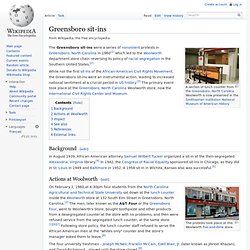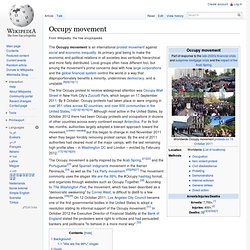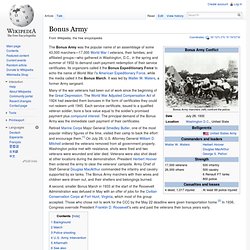

Greensboro sit-ins. The Greensboro sit-ins were a series of nonviolent protests in Greensboro, North Carolina in 1960[1] which led to the Woolworth department store chain reversing its policy of racial segregation in the Southern United States.[2] While not the first sit-ins of the African-American Civil Rights Movement, the Greensboro sit-ins were an instrumental action, leading to increased national sentiment at a crucial period in US history.[3] The primary event took place at the Greensboro, North Carolina Woolworth store, now the International Civil Rights Center and Museum.

Background[edit] In August 1939, African-American attorney Samuel Wilbert Tucker organized a sit-in at the then-segregated Alexandria, Virginia library.[4] In 1942, the Congress of Racial Equality sponsored sit-ins in Chicago, as they did in St. Louis in 1949 and Baltimore in 1952. A 1958 sit-in in Wichita, Kansas also was successful.[5] Actions at Woolworth[edit] More than 300 people took part on the fourth day. Impact[edit] Occupy movement. The Occupy movement is an international protest movement against social and economic inequality, its primary goal being to make the economic and political relations in all societies less vertically hierarchical and more flatly distributed.

Local groups often have different foci, but among the movement's prime concerns deal with how large corporations and the global financial system control the world in a way that disproportionately benefits a minority, undermines democracy, and is unstable.[8][9][10][11] The first Occupy protest to receive widespread attention was Occupy Wall Street in New York City's Zuccotti Park, which began on 17 September 2011. Background[edit] Protests in 1–4 cities Protests in 5–9 cities Protests in 10 or more cities. Bonus Army. The Bonus Army was the popular name of an assemblage of some 43,000 marchers—17,000 World War I veterans, their families, and affiliated groups—who gathered in Washington, D.C., in the spring and summer of 1932 to demand cash-payment redemption of their service certificates.

Its organizers called it the Bonus Expeditionary Force to echo the name of World War I's American Expeditionary Force, while the media called it the Bonus March. It was led by Walter W. Waters, a former Army sergeant. Many of the war veterans had been out of work since the beginning of the Great Depression. The World War Adjusted Compensation Act of 1924 had awarded them bonuses in the form of certificates they could not redeem until 1945. Retired Marine Corps Major General Smedley Butler, one of the most popular military figures of the time, visited their camp to back the effort and encourage them.[1] On July 28, U.S. Occupation of Alcatraz. A lingering sign of the 1969–71 Native American Alcatraz Occupation in 2006.

The "AN" is what remains of an alteration made to the sign, to make it read "United Indian Property". Background[edit] On March 8, 1964, a small group of Sioux demonstrated by occupying the island for four hours.[1] The entire party consisted of about 40 people, including photographers, reporters and Elliot Leighton, the lawyer representing those claiming land stakes. According to Adam Fortunate Eagle, this demonstration was an extension of already prevalent Bay Area street theater used to raise awareness.
The Sioux activists were led by Richard McKenzie, Mark Martinez, Garfield Spotted Elk, Walter Means, and Allen Cottier. Poor People's Campaign. Demonstrators in the Poor People's March at Lafayette Park and Connecticut Avenue in Washington, D.C.

(June 1968) The Poor People's Campaign was a 1968 effort to gain economic justice for poor people in the United States. It was organized by Martin Luther King, Jr. and the Southern Christian Leadership Conference, and carried out in the wake of King's assassination. The Campaign demanded economic and human rights for poor Americans of diverse background. After presenting an organized set of demands to Congress and executive agencies, participants set up a 3000-person tent city on the Washington Mall, where they stayed for six weeks.
Purpose[edit] The Poor People’s Campaign was motivated by a desire for economic justice: the idea that all people should have what they need to live. Dr.